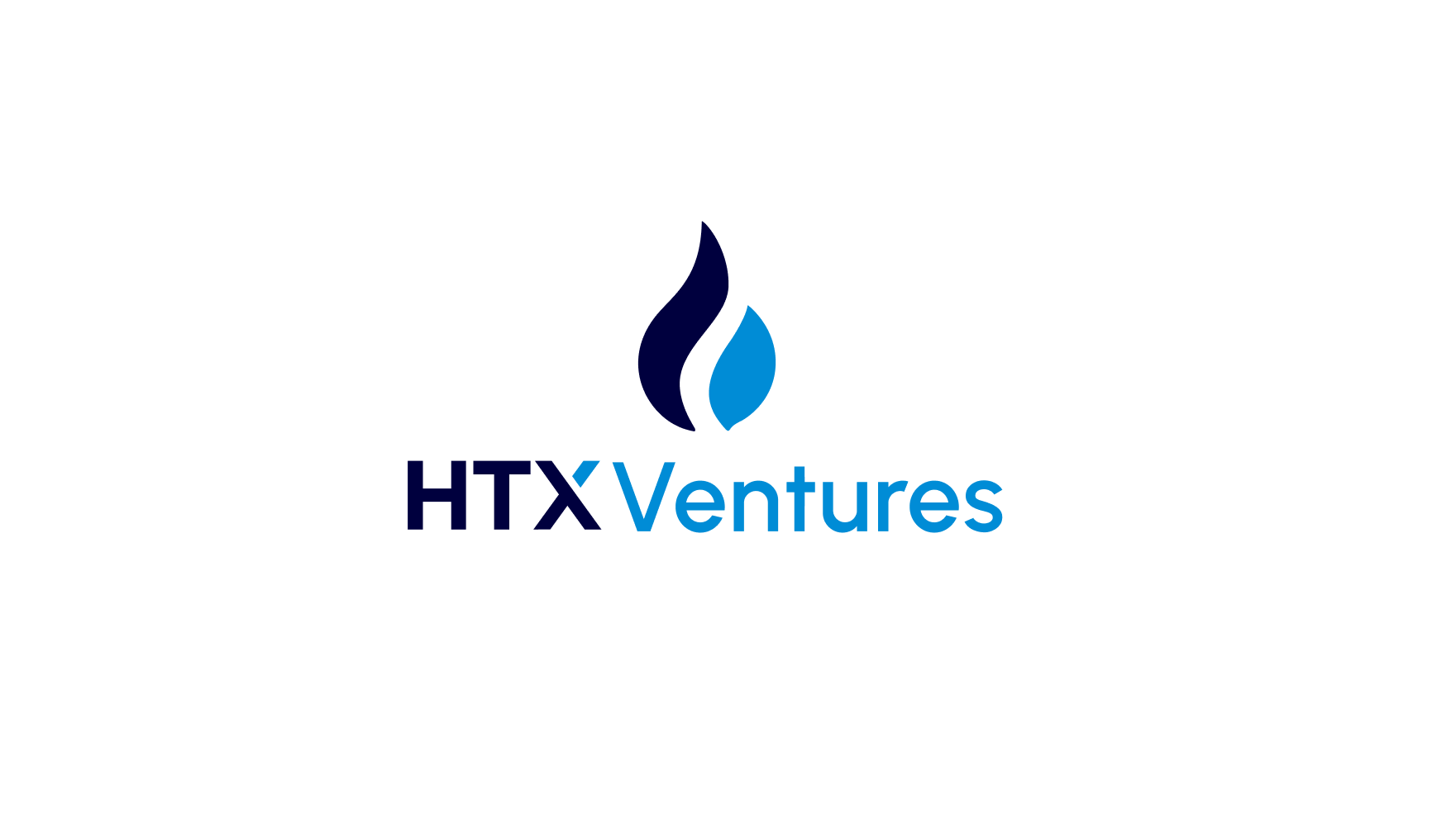1. Brief Introduction to Blockchain and Cryptocurrency Wealth Management
1.1 Background and Significance
The development of blockchain technology since 2008 has greatly changed our world, especially in the financial field. Blockchain technology and cryptocurrency have had a profound impact on the global economy. One prominent point is that they provide new investment and wealth management opportunities for participants in the financial market.
Cryptocurrency wealth management products are one of the latest achievements of applying blockchain technology in the financial services industry. For investors, cryptocurrency wealth management products provide a new and effective way to maintain asset liquidity while also achieving competitive returns. For the global financial market, the development of cryptocurrency wealth management products expands the depth and breadth of the market, provides new risk management tools, and enriches the supply of market products and services.
Therefore, understanding the definition, types, background, and significance of cryptocurrency wealth management products is of great value for investors, market participants, policymakers, and regulators. This article will delve into this topic and provide valuable insights and recommendations for cryptocurrency asset strategies.
1.2 Definition and Types of Cryptocurrency Wealth Management Products
Cryptocurrency wealth management products can be seen as innovative financial services that apply blockchain technology. These wealth management products provide investors with opportunities to store and increase their digital assets. In essence, cryptocurrency wealth management products can also be classified into two main categories: fixed-term and flexible-term, similar to traditional wealth management products. Fixed-term products require investors to lock their funds for a specified period to obtain predetermined returns, while flexible-term products allow investors to deposit and withdraw their funds at any time, although the returns may vary. These two types of products effectively complement traditional bank savings accounts and offer investors new income opportunities.
2. Current Status and Development Trends of Cryptocurrency Wealth Management Market
2.1 Market Size and Growth of Cryptocurrency Wealth Management
According to datos.com statistics, the global cryptocurrency wealth management market has reached $292 billion as early as 2021, with a year-on-year growth of over 600%. It is expected to exceed $5 billion by the current year (2023), indicating the continuous growth of investors' interest and confidence in digital assets. Cryptocurrency wealth management involves digital currencies and their derivatives. Bitcoin is widely regarded as an investment target, and the wave of its transactions has also generated more wealth management tools.
The currently popular forms mainly include: direct investment in Bitcoin, investment in new digital currencies (such as NFT, etc.), and various lending services. Directly holding Bitcoin has always been a popular investment method. In addition, as new tokens continue to be issued, investors are becoming interested in other digital assets. Many custodial institutions are expanding their trust business by absorbing assets and also providing lending services for Bitcoin and other digital tokens, lending out digital tokens to earn interest.
The rapid growth of the cryptocurrency wealth management market is due to the high-risk, high-return nature of digital currencies, and users prefer decentralized and transparent monetary properties. It is predicted that since the occurrence of world extreme events (such as changes in the local geopolitical situation under the influence of trade competition, Russo-Ukrainian conflict, etc.), in the future, as more investors recognize the value of cryptocurrencies, the entire cryptocurrency wealth management market is expected to continue to expand rapidly.
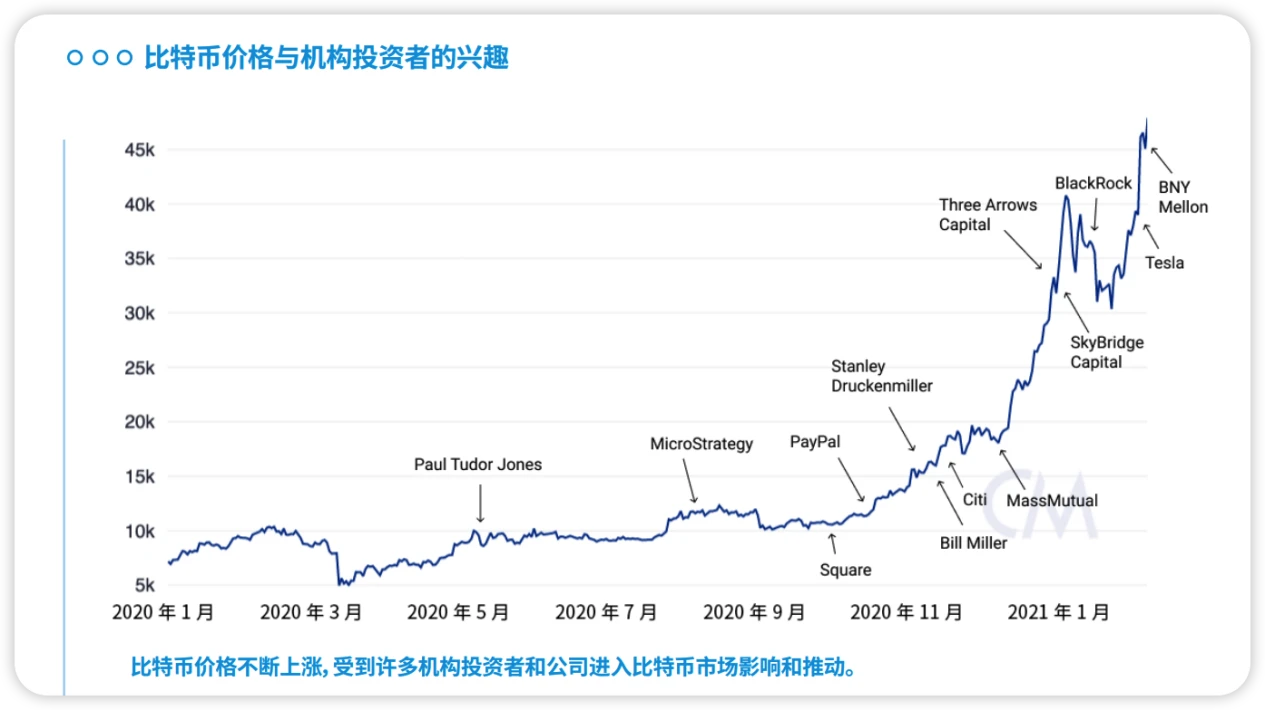
Source: Coin Metrics
2.2 Main investors and their behaviors in cryptocurrency wealth management products
The main investors are mostly young and wealthy technology enthusiasts. They are curious and confident about digital assets and pursue high returns from risk investment. They mostly learn about and participate in investments through online social networks and forums. This group is primarily concentrated in the age range of 30 to 45.
In addition, middle to high-end individuals have also become investors. The high returns offered by cryptocurrency wealth management products attract their participation. These investors often have higher investment capabilities and willingness to take risks.
The common characteristics of cryptocurrency wealth management investors mainly include: high risk tolerance, high recognition of digital currencies, and willingness to participate in emerging markets. They mostly focus on the latest news and data of popular tokens and quickly make investment decisions. However, they need to pay special attention to high-risk factors such as significant fluctuations in the prices of crypto assets.
Their investment behaviors tend to be short-term and medium-term, and long-term holding is not common. They mainly focus on potential earnings rather than long-term asset appreciation.
III. Explanation and Risk Analysis of Cryptocurrency Wealth Management Products
3.1 Introduction to Cryptocurrency Wealth Management Products
Specifically, encrypted financial products are financial activities carried out using encrypted currencies, and their product forms and investment returns vary significantly. They are mainly divided into two categories: decentralized finance (DeFi) financial products and centralized finance (CeFi) financial products. These two types of products have their own characteristics, as well as different risks and returns. When investing, users need to have a clear understanding of them, understand their operating principles and possible risks, in order to make wise investment decisions.
Before delving into these two types of products, we first need to clarify that encrypted financial products are different from traditional financial products. They are not based on government currencies, but on encrypted currencies. This means that they are not constrained by traditional financial systems, but also bring some new challenges and risks, such as market volatility, technical risks, etc.
In the following chapters, we will provide detailed introductions to DeFi and CeFi encrypted financial products, hoping to help readers better understand these two types of products and make more informed investment choices.
3.1.1 DeFi Encrypted Financial Products
3.1.1.1 Curve
Curve is one of the earliest automated market makers (AMMs), initially focusing on trading stablecoins (v2 extended to non-stablecoin trading), providing large-scale, low-slippage stablecoin trading through innovative algorithms.
The main stablecoin pool for Curve on Ethereum is the 3pool, which offers trading between DAI, USDC, and USDT stablecoins, with a maximum yield of 2.44%.
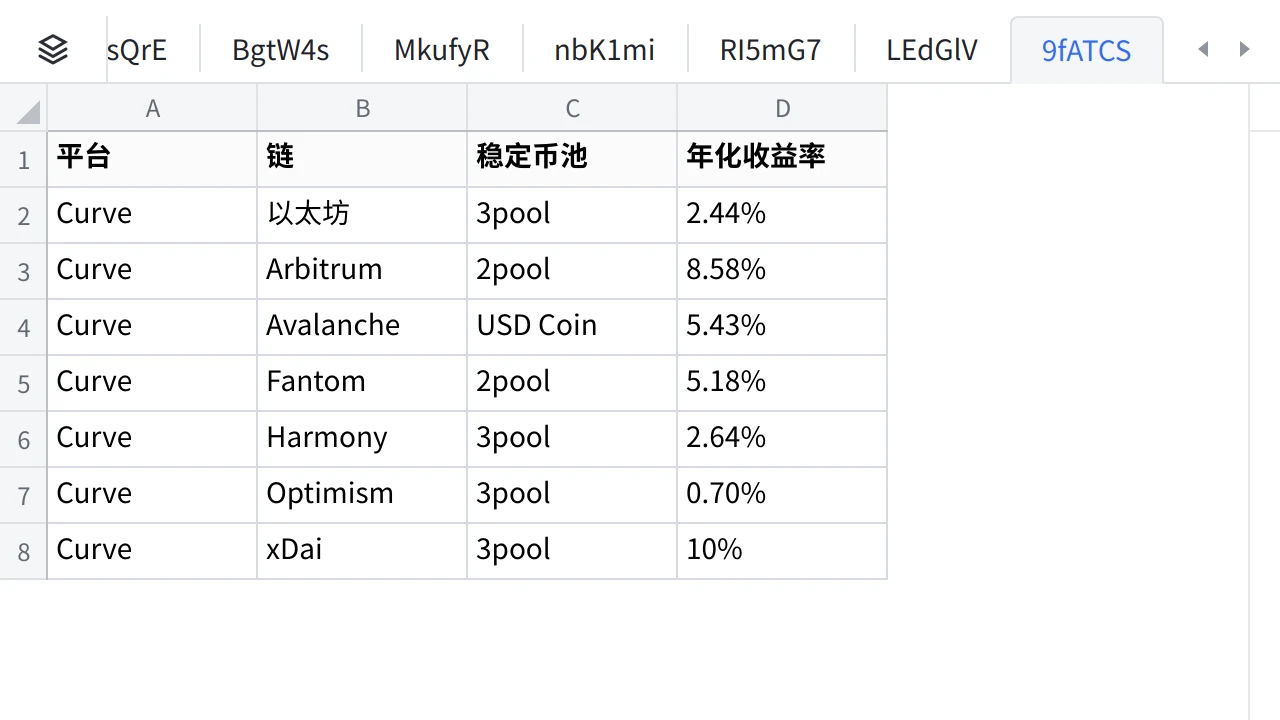
3.1.1.2 Aave
Aave is one of the two giants in the DeFi lending market. Aave provides five markets, including V 1, V 2, AMM, Polygon, and Avalanche. The highest annualized interest rate is in the USDT borrowing pool on the AMM market, with a rate of 7.66%.
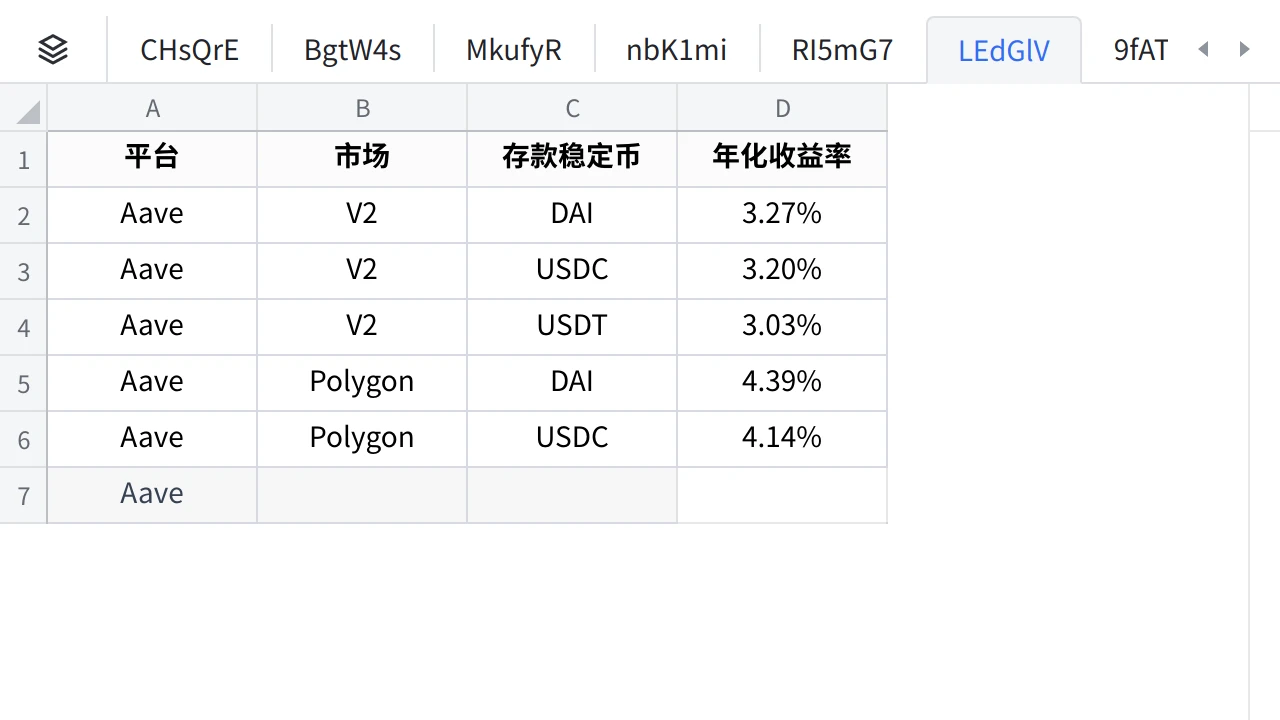
3.1.1.3 Compound
Compound is one of the two giants in the DeFi lending market, currently deployed on the Ethereum network, supporting lending of DAI, USDC, and USDT. According to the latest data, its Total Value Locked (TVL) is $13.2 billion. On Compound, the deposit annualized interest rates for DAI, USDC, and USDT are 2.84%, 2.97%, and 2.52% respectively. The highest interest rate is 2.97% for USDC.
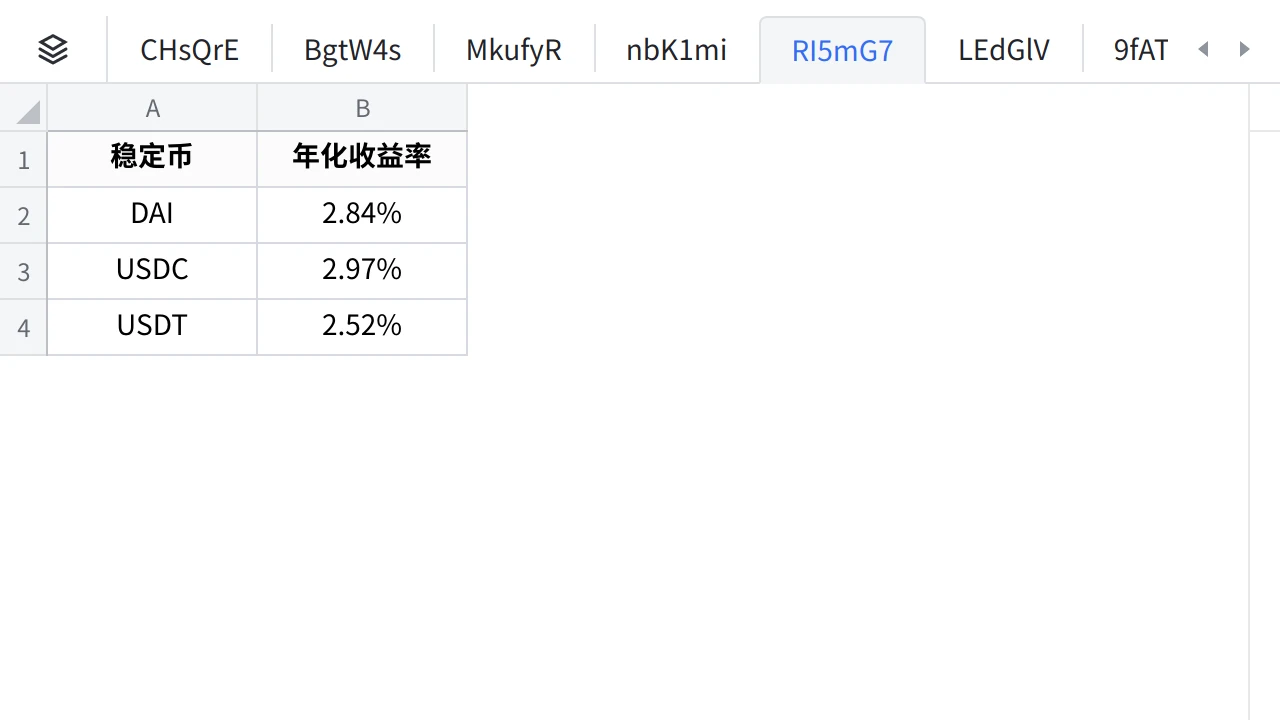
3.1.1.4 Yearn
Yearn is a DeFi yield aggregator with a current total locked value of $4.23 billion. Yearn automatically allocates users' funds to other protocols to maximize their returns. Yearn currently supports Ethereum and Fantom chains, offering two yield-bearing products - Vaults and Iron Bank. Vaults is a yield aggregator product, while Iron Bank is a collateralized lending product. The highest annualized return is on the DAI Vaults on Fantom, with a rate of 24.96%.
Among them, the highest yield on Ethereum-Vaults is for USDT, with a rate of 7.68%, followed by USDC with a yield rate of 5.76%.
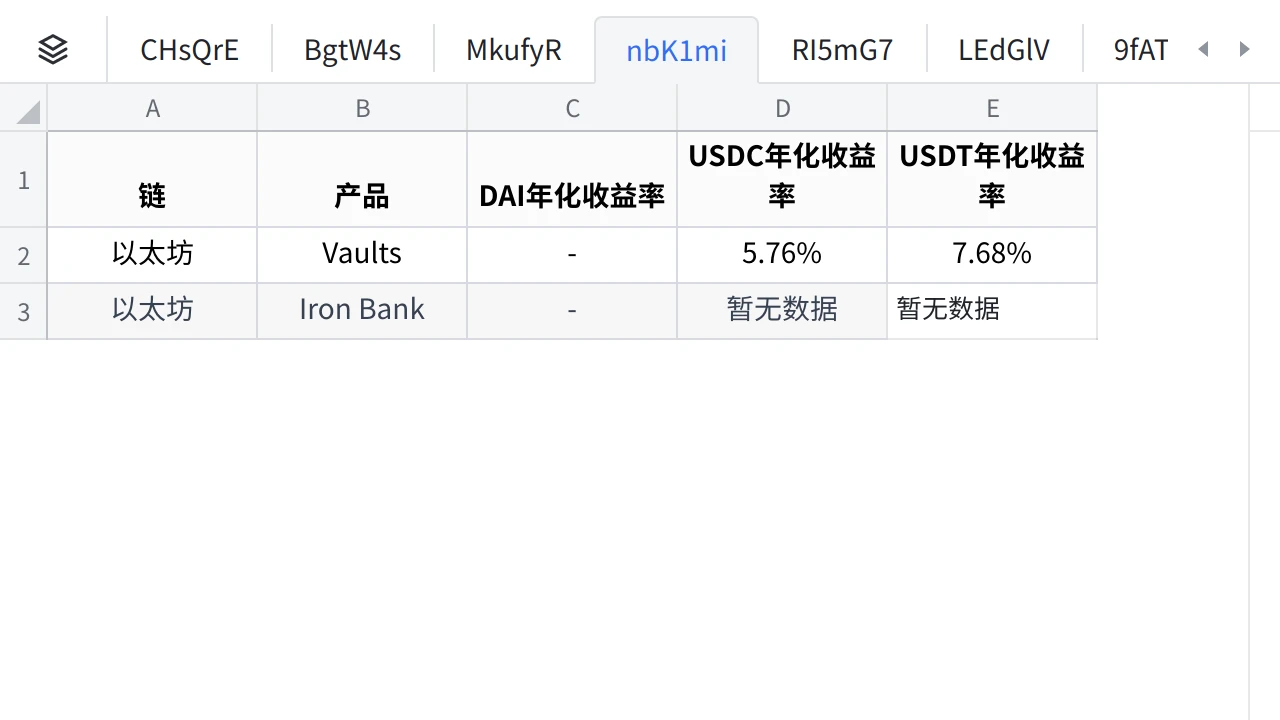
3.1.2 CeFi Crypto Finance Products
3.1.2.1 CeFi Stablecoin Finance
Although decentralized finance (DeFi) is rapidly developing, centralized finance (CeFi) remains an important part of crypto finance. In the field of stablecoin finance, CeFi is mainly concentrated in major exchanges. With its large user base and abundant capital reserves, exchanges provide unique conditions for their finance businesses.
The stablecoin wealth management products offered by exchanges are more like traditional bank wealth management products, combined with the characteristics of blockchain, they have launched a series of new products. Mainly including: current wealth management, fixed-term wealth management, regular investment plan, high-interest current account, dual currency investment, node staking, ETH 2.0, etc. Below, we will introduce the stablecoin wealth management products of four exchanges: Huobi, Binance, OKEx, and Gate.io.
The most typical stablecoin wealth management product of Huobi is the high-interest current account product, which supports on-demand withdrawal and has relatively stable income and high asset security. The supported currencies currently include USDT, DOT, FIL, TUSD, USDC, ETH (other currencies will be launched one after another). The annualized returns and redemption fees of USDT can be referred to as follows:

Applicable investors for Huobi's high-interest current account product:
1. High-net-worth individuals: If you have accumulated a considerable wealth and are seeking high-return investment opportunities, this product is suitable for you as a relatively long-term and stable asset allocation, but you need to bear the cost of short-term redemption fees.
2. Professional investors: If you are an institutional investor, fund manager, or other professional investor. With market insight and investment experience, you can select high-quality wealth management products, and this product also suits for stable and high-return investment.
3. Long-term investors: If you have a sum of money that can be invested for a long time, such as retirement reserves, children's education funds, etc., and you are willing to invest the funds in wealth management products for a long time, this product is also suitable for you, which can help you withstand short-term market fluctuations and lock in stable returns.
Binance, OKEx, and Gate.io are well-known cryptocurrency trading platforms that offer various forms of stablecoin financial products. Among them, Binance is one of the largest exchanges, with a 24-hour trading volume of $12.5 billion according to Coingecko data. It provides products such as Binance Earn and liquidity mining. OKEx and Gate.io, as experienced exchanges, also offer diversified stablecoin financial products, including savings, fixed-term investments, lending, and DeFi mining.
3.1.2.2 CeFi Non-Stablecoin Financial Products
The above description is about the stablecoin financial products offered by major exchanges. Now let's introduce some financial products related to non-stablecoins. Here, we mainly use Huobi as an example.
1. "Dollar-Cost Averaging" Product
"Dollar-Cost Averaging" is a product designed for long-term investors, especially suitable for investors with limited time and lack of investment experience who seek long-term growth and risk diversification. This plan allows investors to invest regularly, enabling them to average down the investment cost and reduce the impact of market volatility, thus achieving the effect of accumulating wealth over time and enjoying the benefits of compound interest.
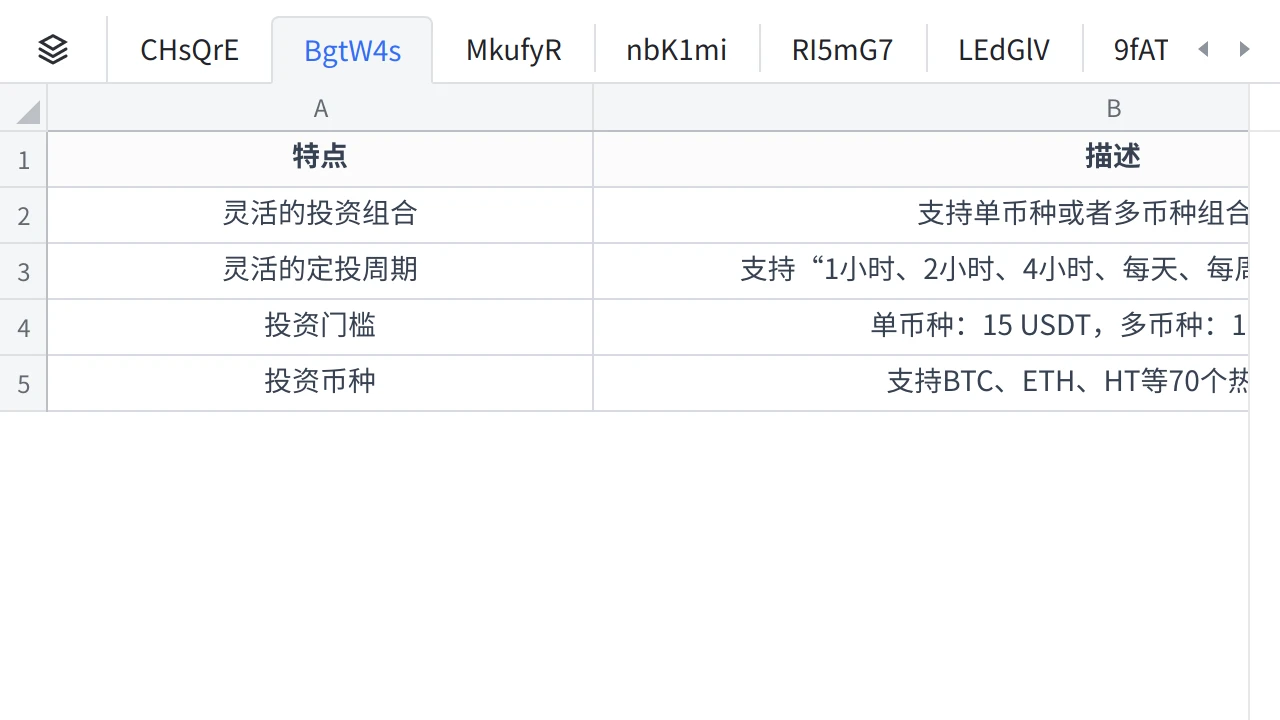
This plan is particularly suitable for investors who use dollar-cost averaging strategy, busy professionals, long-term investors, and small investors.
2. Spot Balance Auto-Investment
Spot balance auto-investment is a convenient investment method that can be activated with a single click. It helps investors easily invest in all supported coins for spot savings. Through this method, investors can achieve automatic compound investment of their assets while enjoying flexible subscription and redemption.
3.2 Main Types of Risks in Cryptocurrency Financial Products
Although cryptocurrency financial products offer potential high returns to investors, like any investment, they also come with certain risks. Due to the characteristics of cryptocurrency, these risks can be higher. These risks mainly include the following:
3.2.1 Market Risk
The cryptocurrency market is highly volatile. Price fluctuations can be significant and are often caused by various uncertainties, including technological changes, policy or regulatory changes, changes in market participants' sentiment, and more. For example, the release of new technology or policy that may benefit a particular cryptocurrency can lead to an increase in its price. Conversely, unfavorable news or events can cause the price to decline. In some cases, these fluctuations can be very drastic, with significant increases or decreases in price within a short period of time.
3.2.2 Liquidity Risk
Liquidity risk refers to whether investors can buy or sell assets quickly at a reasonable price when needed. For cryptocurrencies with low liquidity, if there is a shortage of buyers in the market, investors may have to sell their cryptocurrencies at a price lower than the market price, resulting in losses. Similarly, if there is a shortage of sellers in the market, investors may have to purchase cryptocurrencies at a price higher than the market price. Furthermore, cryptocurrencies with low liquidity may be more susceptible to price fluctuations due to large transactions.
3.2.3 Technical Risk
The infrastructure of cryptocurrencies, including blockchain and smart contracts, relies on complex technologies. These technologies may have undiscovered vulnerabilities that can be exploited for attacks, resulting in asset loss for investors. Furthermore, due to the anonymity and irreversibility of cryptocurrencies, technical failures or operational mistakes may render investors unable to recover their assets.
3.2.4 Regulatory Risks
Different countries around the world have varying attitudes and policies towards cryptocurrency regulation. Some countries or regions may be supportive of cryptocurrencies and have policies encouraging their development. However, there are also countries or regions that may hold cautious or even negative attitudes towards cryptocurrencies, implementing strict regulatory policies. Changes in these policies can directly impact the value and availability of cryptocurrencies.
IV. Legal and Regulatory Environment for Cryptocurrency Wealth Management Products
4.1 Overview of the Legal and Regulatory Environment for Cryptocurrency Wealth Management Products Worldwide
The legal and regulatory environment for cryptocurrency wealth management products is extremely diverse globally. For example, the U.S. Securities and Exchange Commission (SEC) has established certain regulations for cryptocurrencies, categorizing certain cryptocurrencies as securities, which require related cryptocurrency wealth management products to comply with securities laws. Europe has implemented Anti-Money Laundering (AML) and Know Your Customer (KYC) regulations for cryptocurrency exchanges. However, countries like China and India have strict control policies on cryptocurrencies, prohibiting activities such as cryptocurrency trading and mining.
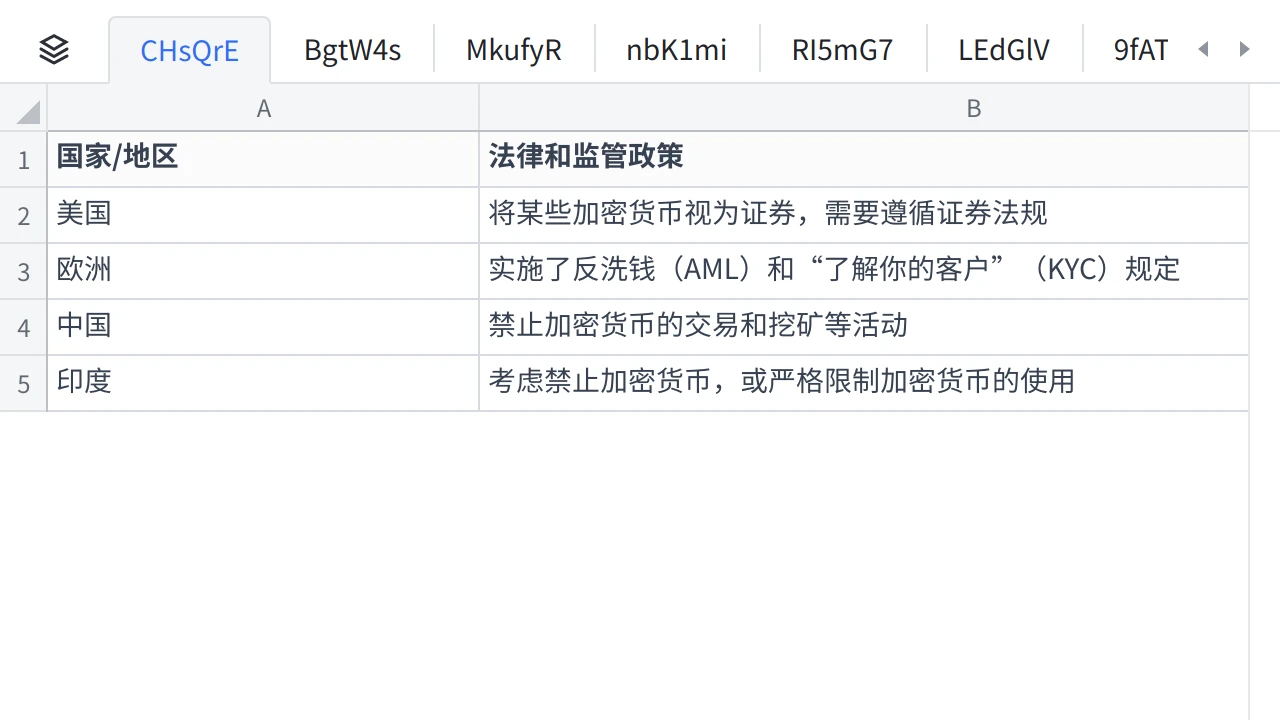
4.2 Impact of Different Countries' Regulatory Attitudes and Policies
The regulatory attitude and policies of different countries have a significant impact on the market development of cryptocurrency financial products. For example, countries like Switzerland and Singapore, which have an open attitude towards cryptocurrencies, have active cryptocurrency markets and attract a large number of cryptocurrency companies and investors. On the other hand, countries like China and India, which have strict policies on cryptocurrencies, have limited development in their domestic cryptocurrency markets.
4.3 Impact of Regulatory Environment on Market Development
A clear and stable regulatory environment can help improve market transparency, protect investor interests, and attract more investment. However, excessive or unclear regulation may have negative effects on the market. For example, in 2017, the Chinese government banned Initial Coin Offerings (ICOs) for cryptocurrencies, which led to many cryptocurrency projects and investors leaving China. On the other hand, the regulation of cryptocurrencies by the U.S. SEC, while putting pressure on some cryptocurrency companies, also helps maintain market order and protect investor interests.
V. Future Development of Cryptocurrency Financial Products and Strategic Recommendations
5.1 Development Potential and Challenges of Cryptocurrency Financial Products
5.1.1 Tremendous Development Potential of Cryptocurrency Financial Products
Cryptocurrency financial products have tremendous development potential in the future. With the advancement of technology, cryptocurrencies are gradually being accepted by the public and applied in various scenarios, including cross-border remittances, insurance, supply chain finance, etc. As a type of financial service, financial products contribute to the development of cryptocurrencies and meet users' investment and financial needs.
According to a report by Markets and Markets, the global cryptocurrency asset management market is expected to have a compound annual growth rate (CAGR) of 21.5% between 2021 and 2026. Research And Markets is even more optimistic, predicting a compound annual growth rate of 82.4% for the global blockchain market between 2021 and 2028, with the market size reaching $394.6 billion by 2028.
Increasing demand for encrypted wealth management in home offices:
For long-term funds such as high-net-worth clients, family offices, and university endowment funds, properly allocating assets such as Bitcoin can effectively resist inflation, increase asset returns, and reduce overall asset volatility. According to a research report by Galaxy Digital in November 2020, allocating 7% of total assets to Bitcoin maximizes the asset return and risk ratio, known as the Sharpe Ratio. A research report by Coinshares in November 2021 points out that only about 1% of institutionally managed assets are currently allocated to encrypted assets. Considering the trillions of dollars in assets managed by institutions, increasing the allocation from the current 1% to 7% would bring trillions of dollars to the encrypted asset management market.
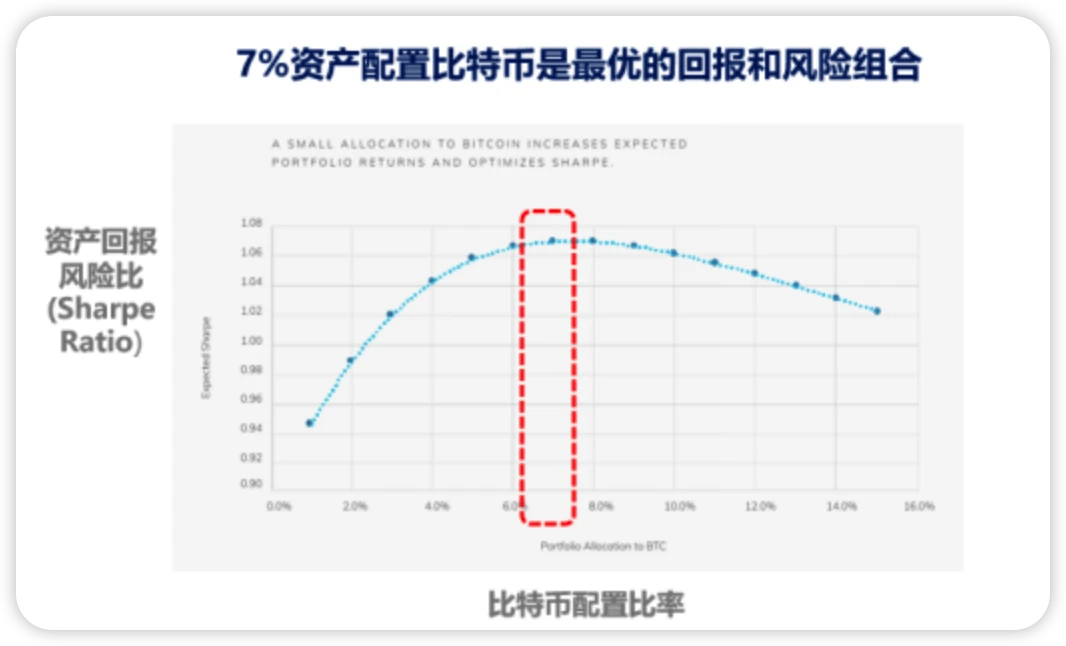
However, confidence in the future growth of encrypted asset management has been shaken after Bitcoin's sharp decline in May. The main reason for the current bear market of encrypted assets is the global economy and macro environment, with the direct trigger being the global decline in asset prices caused by the Fed's interest rate hike and balance sheet reduction. Since May-June 2022, with the death spiral of LUNA, the blow-up of FTX, and so on, the entire crypto market has entered a rapid decline, with a slight rebound around June 2023 (at the time of writing this article).
Although the market is currently recovering from the bear market, the heat in the wealth management market has not yet reached its peak. However, in the long term, encrypted assets represented by Bitcoin are still in a stage of rapid development.
5.1.2 Challenges of cryptocurrency wealth management
➀ Valuation dilemma and volatility of encrypted assets
The valuation of encrypted assets faces significant challenges due to the absence of a recognized valuation system, leading to frequent market speculation and volatile prices. This not only increases the difficulty for fund managers in investment decisions and risk control but also makes regulatory agencies and institutional investors cautious about encrypted assets. These factors collectively hinder the substantial development of the cryptocurrency wealth management industry.
➁Fragmentation of global regulatory frameworks
Although some countries have issued fund management licenses for encrypted asset management or incorporated them into existing fund management systems, global regulation still exhibits fragmentation. This does not align with the cross-border flow and globalization characteristics of encrypted assets. When dealing with the influences from different countries, regulatory systems, and policies, global compliance costs are extremely high for encrypted asset management companies. Particularly after the collapse of the Terra/UST stablecoin, regulatory agencies have intensified their focus on stablecoins. Due to the lack of mature stablecoin regulatory systems globally, the cryptocurrency management industry faces significant risks arising from stablecoin regulatory uncertainties.
➂Imperfections of encrypted asset management systems
Compared to traditional fund management systems, encrypted asset management systems are still in the rapid development stage. Traditional system service providers have yet to delve extensively into this field, and the uniqueness of encrypted assets makes the construction of asset management systems challenging and costly.
Some reputable encrypted asset management companies, such as BBshares, Amber Group, or asset management companies under exchanges, have to invest significant resources to develop dedicated encrypted asset management systems. These systems need to provide comprehensive services, from front-end trading, mid-end fund management and risk management, to back-end reporting and reconciliation, API key encrypted cryptocurrency multi-signature management, etc. Independently developing and maintaining a new set of encrypted asset management systems is a heavy burden for fund companies, hindering the industry's rapid development towards greater specialization.
➃Security and network attack risks
The decentralized and online nature of cryptocurrencies makes them vulnerable to network attacks and security vulnerabilities. Hackers may exploit technological means to steal encrypted assets, causing significant losses to investors and management companies. Therefore, cryptocurrency wealth management companies need to allocate substantial resources to ensure security protection, enhance system security, and mitigate potential security risks.
➄Insufficient market transparency
The cryptocurrency market is less transparent compared to traditional financial markets. There may be insider trading and market manipulation by exchanges and project teams, which brings additional risks to cryptocurrency investment. In addition, the anonymity of cryptocurrencies can lead to illegal activities by some investors, causing negative impacts on the entire industry.
➅ Liquidity issues between fiat and cryptocurrencies
Although the liquidity in the cryptocurrency market is increasing, there are still challenges in exchanging cryptocurrencies with fiat currencies. Exchanges and financial institutions may restrict exchange amounts or charge high fees, adding extra burden and risks to cryptocurrency investment.
➆ Education and trust issues for retail investors
Many retail investors lack understanding of cryptocurrencies and related investment products, which may lead to misunderstandings and panic about cryptocurrency investment. Therefore, cryptocurrency investment companies need to enhance education and communication efforts to help investors understand the risks and returns of cryptocurrencies and build trust.
In conclusion, the challenges faced by the cryptocurrency investment industry include valuation systems, regulatory frameworks, asset management systems, security, market transparency, technological development, liquidity issues, and education and trust of retail investors. To address these challenges, the industry needs collective efforts to promote the prosperous development of the cryptocurrency investment market.
5.2 Recommendations for Investors
For investors, the cryptocurrency market is a new type of market where risk management measures, classification of investment products, and regulations in different regions are still under development. The following points are suggested:
1. Manage risks effectively: Due to the high price volatility of cryptocurrencies, investors should clearly understand their risk tolerance and allocate investment funds accordingly.
2. Understand investment products: Investors should have a deep understanding of the products they invest in, including their operational mechanisms and sources of returns.
3. Stay updated on regulatory trends: Investors should closely monitor global cryptocurrency regulations to timely adjust their investment strategies.
5.3 Recommendations for Policymakers and Regulatory Authorities
For policymakers and regulatory authorities, the following recommendations are made:
1. Establish clear regulatory policies: Policymakers and regulatory authorities should develop clear regulations for cryptocurrency investment products, providing the market with clear rules.
2. Strengthen investor education: Policy makers and regulatory agencies should strengthen investor education on financial knowledge and risk awareness through various means.
3. Establish a reasonable risk prevention and control mechanism: Regulatory agencies should establish a reasonable risk prevention and control mechanism, such as formulating anti-money laundering and counter-terrorism financing rules, and improving cryptocurrency transactions
About Huobi Research Institute
Huobi Blockchain Application Research Institute (referred to as "Huobi Research Institute") was established in April 2016 and has been committed to comprehensive exploration and research in various fields of blockchain since March 2018. It takes the broad field of blockchain as its research object and aims to accelerate the research and development of blockchain technology, promote the application of blockchain industry, and optimize the blockchain industry ecology. The main research areas include industry trends, technical paths, application innovations, and model explorations in the field of blockchain. Adhering to the principles of public welfare, rigor, and innovation, Huobi Research Institute will carry out extensive and in-depth cooperation with governments, enterprises, universities, and other institutions in various forms, establish a research platform covering the entire blockchain industry chain, provide solid theoretical foundation and trend judgment for professionals in the blockchain industry, and promote the healthy and sustainable development of the entire blockchain industry.
Contact Us:
https://research.huobi.com/
Disclaimer
1. There is no relevant relationship between Huobi Blockchain Research Institute and the projects or other third parties mentioned in this report that would affect the objectivity, independence, and impartiality of the report.
2. The information and data quoted in this report are from compliant channels, and the sources of the information and data are considered reliable by Huobi Blockchain Research Institute, and the authenticity, accuracy, and completeness have been verified as necessary. However, Huobi Blockchain Research Institute does not make any guarantee regarding the authenticity, accuracy, or completeness.
3. The content of the report is for reference only. The conclusions and opinions in the report do not constitute any investment advice for relevant digital assets. Huobi Blockchain Research Institute shall not be liable for any loss caused by the use of the content of this report, unless otherwise provided by laws and regulations. Readers should not make investment decisions solely based on this report, nor should they lose their ability to make independent judgments based on this report.
4. The information, opinions, and speculations contained in this report only reflect the judgments of the researchers on the day of the final draft of this report. In the future, based on changes in the industry and data information, there may be possibilities of updating viewpoints and judgments.
5. The copyright of this report belongs to Huobi Blockchain Research Institute. If you need to quote the content of this report, please indicate the source. If you need to quote extensively, please inform in advance and use within the allowed range. Under no circumstances should this report be quoted, abridged, or modified in any way that contradicts its original intention.

